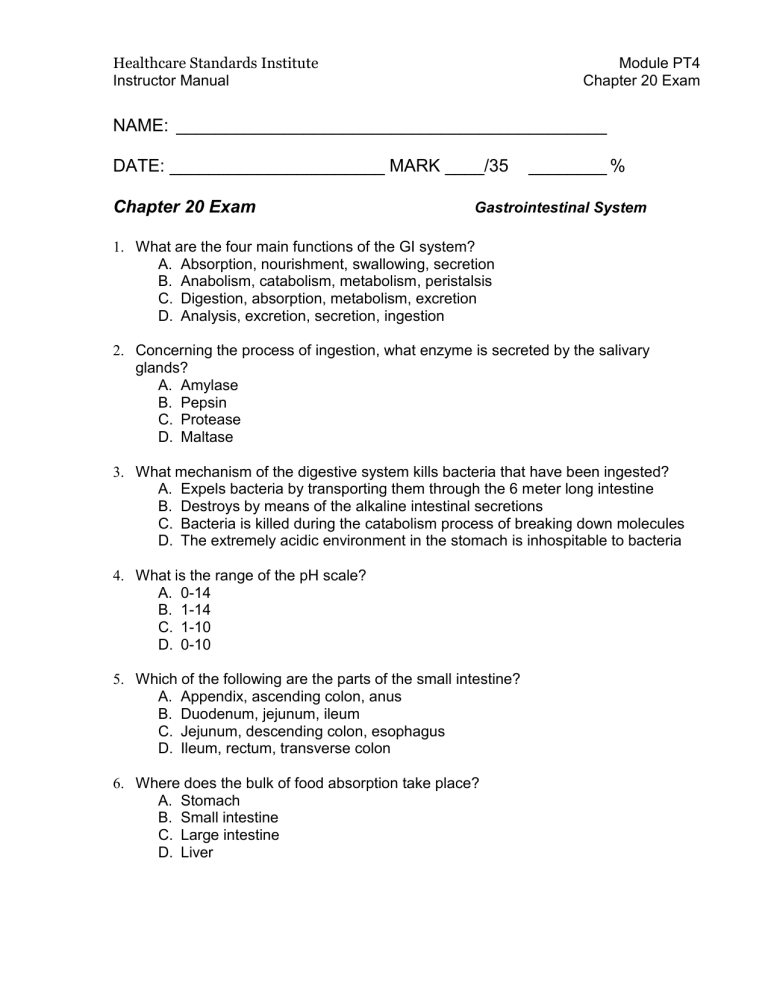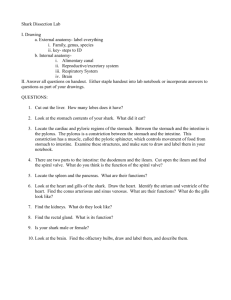Chapter 21 Exam and Answer Key revised

Healthcare Standards Institute
Instructor Manual
Module PT4
Chapter 20 Exam
NAME: ____________________________________________
DATE: ______________________ MARK ____/35 ________ %
Chapter 20 Exam
Gastrointestinal System
1.
What are the four main functions of the GI system?
A. Absorption, nourishment, swallowing, secretion
B. Anabolism, catabolism, metabolism, peristalsis
C. Digestion, absorption, metabolism, excretion
D. Analysis, excretion, secretion, ingestion
2.
Concerning the process of ingestion, what enzyme is secreted by the salivary glands?
A. Amylase
B. Pepsin
C. Protease
D. Maltase
3.
What mechanism of the digestive system kills bacteria that have been ingested?
A. Expels bacteria by transporting them through the 6 meter long intestine
B. Destroys by means of the alkaline intestinal secretions
C. Bacteria is killed during the catabolism process of breaking down molecules
D. The extremely acidic environment in the stomach is inhospitable to bacteria
4.
What is the range of the pH scale?
A. 0-14
B. 1-14
C. 1-10
D. 0-10
5.
Which of the following are the parts of the small intestine?
A. Appendix, ascending colon, anus
B. Duodenum, jejunum, ileum
C. Jejunum, descending colon, esophagus
D. Ileum, rectum, transverse colon
6.
Where does the bulk of food absorption take place?
A. Stomach
B. Small intestine
C. Large intestine
D. Liver
Healthcare Standards Institute
Instructor Manual
7.
What breaks down large protein molecules?
A. Polypepsin, lipase, and lactase
B. Pepsin, maltase and trypsin
C. Pepsin, trypsin and chymotrypsin
D. Polypepsin, lipase and chymopepsin
8.
What are the three auxiliary organs of the GI system?
Module PT4
Chapter 20 Exam
______________________________________________________________________
______________________________________________________________________
9.
What is absorbed by the large intestine?
A. Proteins
B. Fats
C. Electrolytes
D. All the above
10.
What type of antacid should be avoided while taking ciprofloxacin?
A. Those with calcium, magnesium, or aluminum
B. Any antacid
C. Those with sodium or potassium
D. Those with calcium or saccharine
11.
Why must patients taking tetracycline avoid taking certain antacids?
A. Tetracycline interferes with the antacid action of neutralizing stomach acid
B. The combination can cause diarrhea
C. Absorption of tetracycline may be impaired
D. Tetracycline must be broken down by a very acidic stomach
12.
What side effect is a result of taking too much of a preparation containing aluminum?
A. Diarrhea
B. Constipation
C. Ulcers
D. Hemorrhoids
13.
What is the drug action of H
2
receptor antagonists?
A. Decrease acid secretions
B. Block gastric acid secretion
C. Slow intestinal motility
D. Lower the acidity of the stomach
Healthcare Standards Institute
Instructor Manual
Module PT4
Chapter 20 Exam
14.
How is the presence of H.pylori confirmed?
A. High levels of urea in the blood
B. Bacterial growth on a petri dish
C. Elevated levels of an antibody to H.pylori
D. All of the above
15.
What is characteristic of H.pylori
?
A. It is a gram positive bacillus and causes peptic ulcers
B. Caused by excessive consumption NSAIDs and antacids
C. Can be treated with a combination of antivirals, antiflatulents and PPIs
D. It is a gram negative bacillus and has been linked to stomach cancer
16.
What is the treatment for H.pylori
?
A. Several agents given in a specific order
B. Several agents given simultaneously
C. There is no treatment
D. A combination of drugs and radiation
17.
What is the drug action for proton pump inhibitors?
A. Block gastric acid secretion in the stomach
B. Stimulate peristalsis
C. Lower the acidity of the stomach
D. Slow intestinal motility
18.
Which side effect is associated with the use of Pepto Bismol?
A. May cause bloating, gas, and cramping
B. Liquid forms must be diluted before administration to reduce risk of throat irritation
C. Stools may appear greyish-black
D. May cause dry mouth, dizziness, and drowsiness
19.
Which of the following is a laxative agent?
A. metoclopramide
B. esomeprazole magnesium
C. sodium phosphates
D. diphenoxylate and atropine
20.
What can activate the chemoreceptor trigger zone?
A. Pain, medication and emotions
B. Smell, motion sickness and stress
C. Motion sickness, stress and medication
D. Emotions, taste and pain
Healthcare Standards Institute
Instructor Manual
Module PT4
Chapter 20 Exam
21.
Why are many antiemetics only available by prescription?
A. They are usually used with chemotherapy patients and must be monitored
B. They are very strong medications which override the body's reflex
C. They affect the chemoreceptor trigger zone
D. They cross the blood brain barrier causing sedation
22.
What classification does simethicone belong to?
A. Antiemetic
B. Antidiarrheal
C. Antiflatulent
D. Laxative
23.
What is the generic name for Zofran?
A. dimenhydrinate
B. ondansetron
C. meclizine
D. scopolamine
24.
What is the drug action of a hyperosmolar laxative?
A. Retain water that is already in the colon to soften stool
B. Increases the mucosal lining and softens stools
C. Pull H
2
O and fatty compounds into the intestine
D. Uses aluminum to bind the stool
Match the trade name on the left with the generic names on the right. Indicate your answer using an alphabetical letter.
____ 25.
Axid A.
famotidine
____ 26.
Imodium B.
simethicone
____ 27.
Nexium
____ 28.
Colace
____ 29.
Zantac
C.
D.
E.
lansoprazole
psyllium
rabeprazole
____ 30.
Dulcolax
____ 31.
Metamucil
____ 32.
Prevacid
____ 33.
Pepcid
____ 34.
Gas-x
____ 35.
Pariet
F.
bisacodyl
G.
loperamide
H.
ranitidine
I.
nizatidine
J.
esomeprazole
K.
docusate
Healthcare Standards Institute
Instructor Manual
Chapter 21 Exam – Answer Key
1. C
– pg. 698
2. A
– pg. 699
3. D
– pg. 700
4. A – pg. 700
5. B – pg. 701
6. B – pg. 700, 701
7. C – pg. 702
8. Pancreas, liver, gallbladder - pg. 702
9. C
– pg. 702
10. A
– pg. 705
11. C
– pg. 705
12. B
– pg. 713
13. A
– pg. 706
14. C
– pg. 710
15. D
– pg. 710
16. B
– pg. 710
17. A
– pg. 708
Module PT4
Chapter 20 Exam
– Answer Key
Gastrointestinal System
18. C
– pg. 713
19. C
– pg. 715
20. A
– pg. 721
21. C – pg. 722
22. C – pg. 717
23. B – pg. 723
24. A – pg. 716
25. I – pg. 708
26. G – pg. 713
27. J – pg. 709
28. K – pg. 715
29. H – pg. 707
30. F – pg. 716
31. D – pg. 715
32. C – pg. 708
33. A – pg. 708
34. B
– pg. 718
35. E
– pg. 709








